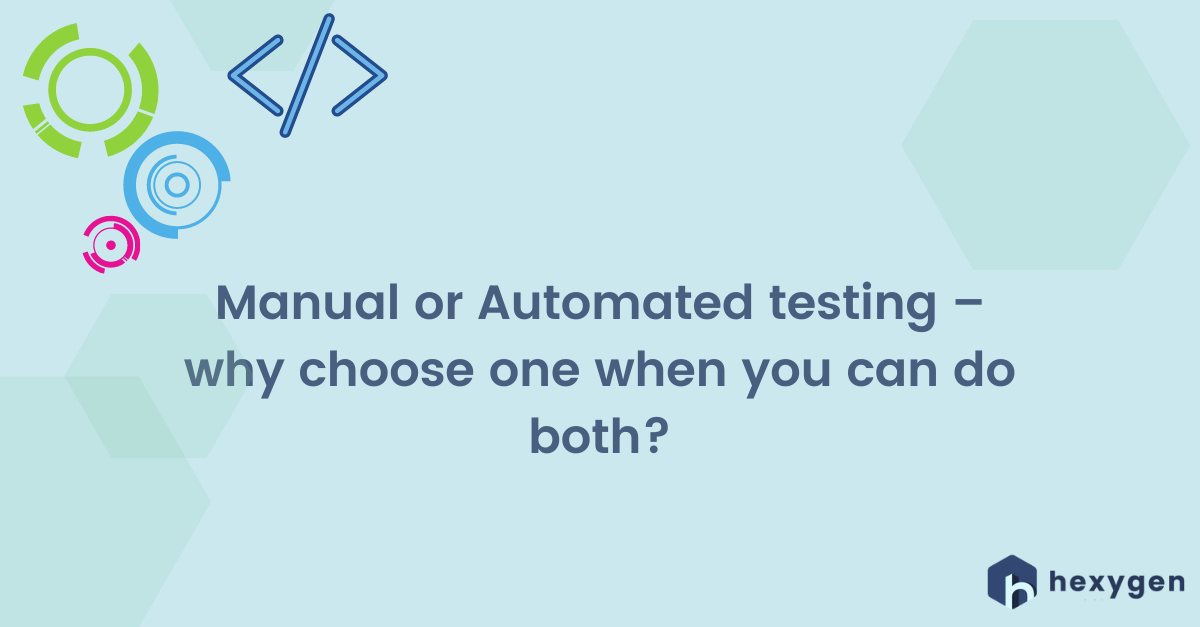
Software testing is the key to successful software development. There is no better way of making sure that the product you provide is of superior quality. Unlike quality assurance and quality control, which are high-level organizational practices, software testing is a hands-on activity that can be assigned to a particular team member.
There are two ways of testing software: manual and automated. But which of the two is actually better and why? To find that out let’s take a closer look at them and examine both their advantages and disadvantages.
What is manual testing?
Let’s start by defining what it actually is. Manual testing is the process of checking a piece of software against both functional and non-functional requirements conducted by hand. A tester runs the actual application on different devices and uses it as the end users would. This process aims to find any deviations from the original requirements related to the app’s functionality, user experience (UX), and design. To be sure that he or she covers all requirements, features, and use scenarios, a manual tester uses predefined test cases.
The advantages of manual testing
Manual testing allows for the most precise simulation of the real-life environment in which your application will be used. Not only will it allow you to find any bugs or flaws in the application, but also it will provide a real person’s feedback on the solution’s look and feel. To put it simply: a machine will not tell you that font is too small to read, a background image too colorful and distracting, and a particular button too small to hit it on a smartphone. And having a product that works exactly the way users need is the key to it being purchased by others.
To start manual testing you do not have to invest in any expensive tools. You do need software e.g. writing the test plan, executing tests, or duplicating and fixing defects, but most of it you already have (e.g. Jira, Microsoft Office). And any additional tool that you need will not put a strain on your budget (e.g. your preferred testing tool, Jenkins, Bitbucket). You also need a tester or a group of testers. They will give you an additional advantage of quickly testing something and seeing the results or instantly reacting to the slightest requirement change (e.g., a new feature, a change in the user interface – UI).
The drawbacks of manual testing
But all of this comes at a price. Manual testing is typically labor-intensive, and as such it is slower than simply running a script. Also, as your product grows, so does the time-consumption of testing it, requiring you to spend more and more on manual testers. And since people are prone to make mistakes, depending on manual testing might turn out to be less accurate and thorough. Even if you decide to retest something, i.e., run manual tests more than once or twice, you may tire your testers plus their acquired familiarity with your piece of software will make them miss any new bugs in it.
Finally, manual tests can not be reused the way automated tests can. Every time a major change is introduced to the product, you need to retest the whole product to make sure it has not broken anything.
Now let’s examine the alternative.
What is automated testing?
Automated testing is a process of executing pre-scripted tests on a piece of software before releasing it into production. Automated testing relies on using dedicated tools that execute tests and report their results and compare them with earlier test runs. Automated testing requires less human participation than manual testing and allows for running multiple tests simultaneously and rerunning them at any time.
The advantages of automated testing
Since it is done by a machine, automated testing is much less time-consuming. Once you set it up, it does all the work autonomously. Also, it can run the tests simultaneously on various machines and browsers. And as it relies only on algorithms and completely excludes the human factor, it is more thorough and unbiased. Automated testing is also more transparent and allows all stakeholders to see the results of the testing in real-time.
Even though you need to invest in automated testing software, it proves to be more cost-efficient in the long run. As your product grows you only need to add more test cases and repeat them if necessary to stay on top of things.
The drawbacks of automated testing
As we mentioned, automated testing requires you to make an initial investment and then requires continuous maintenance (including upgrades) to work properly. Also, automated software will not provide an unbiased opinion on your app’s UX or design. Machines can not replicate human behavior and do not experience things. All they can do is to check different elements of a piece of software against given parameters.
Automatic tests take more time to set up, which does not allow you to test ideas quickly and easily. Machines are indeed great at faultless repetition, but they are not as effective at exploring possibilities and following hunches. Again, they lack the human factor. You also need to bear in mind that third-party automation software will not always be able to test your product thoroughly, plus it can have bugs of its own which can negatively impact your entire testing process.
Manual vs. automated testing: which one works best for you
So, having learned about the main pros and cons of both manual and automated testing, let’s go back to the question we asked at the beginning of this article: which one of these two is better and why? Well, there is no right way to answer it as neither of the approaches is better than the other.
-
Manual testing is great for smaller, short-term projects and minor changes as it requires less investment and effort to set up. Automated testing would not make sense in such projects because the cost of setting it all up would exceed the value it would bring to a piece of software.
-
Manual testing is also great for more UI/UX-oriented products. A subjective validation provided by a human tester can do wonders.
-
Automated testing on the other hand is the right choice for bigger and long-term projects with millions of lines of code as it would be humanly impossible to test it manually.
-
Automated testing also allows you to test the entire product at every iteration with almost no effort.
-
Automated testing is also the right choice for testing repetitive items, e.g. main product path in the Regression Testing process.
So, if neither of them is perfect and they seem to be complimentary, it is your best bet to use the combination of them both. Use automated testing for more complex, feature-rich systems, but make sure you thoroughly test product usability using a human tester. Striking a balance between two complementary ways of doing things seems to be the approach Mother Nature intended for a variety of things, software testing included 😉
Software testing management made easy
Before embarking on yet another software development project, consider moving your testing process to Jira, using our Requirements and Test Management for Jira app. Not only will it allow you to create a reliable, well-organized testing workflow, but also it will increase the overall effectiveness of your team’s work, saving a lot of your precious time, money, and other resources. Do not just take our word for it – at present, there are already almost 1,200 active instances of the app on five continents.
And now you can try it out for free for 30 days! To start your free no-obligation trial, go to the Atlassian Marketplace right away and select your hosting type. And to see our app in action, book a free live demo via Calendly here – we will be more than happy to show you all the magic this little app of ours is capable of 🙂


